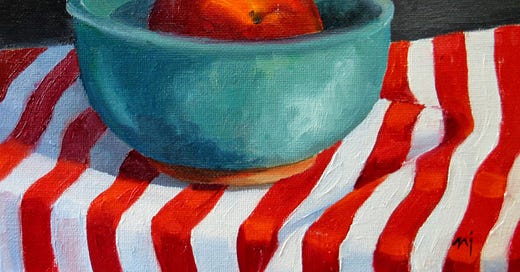#12 | The Peach in the Bowl
Quarantine aestheticism, the history of Cape Muslim cuisine, and the Sqirl story
Hello. Thanks for being here.
This is the twelfth edition of In Digestion, a weekly survey of the best food media on the web, and why you should care about it. If you like this newsletter, please follow @in_digestion and @jameskhansen on Twitter, and forward it to a large number of people. It should feel like too many. It won’t be enough. Thank you.
More of an administrative intro this week — when do you want to read In Digestion? Paid subscriber Saturdays are settled, but I’d love your feedback on when you want the weekly round-up: an ease-in to the week on a Monday morning, or a glance backward on a Friday? Or, maybe, something else entirely. Email me at hellojameshansen@gmail.com with your thoughts, on this and indeed anything else. Thank you so much to everybody reading this, and I’ll be back on the analysis train next week. Have a lovely weekend, hopefully basking in the wonderful writing below.
Reina Gattuso reports on the socioeconomic forces that consign vegetables to history for Atlas Obscura. The central character is Akash Muralidharan, who experiences that familiar sensation of parents turning a childhood room into a storage locker and finds a cookbook, Samaithu Par, “a classic text of 20th-century vegetarian Tamil Brahmin cooking.” Its contents — dishes calling for vegetables he had never seen — propel him into a story of industrial agricultural devastation, cultural preservation, and saved seeds squirrelled away like secrets. The result is a collage of illustrations that both memorialise and maintain Tamil Brahmin culinary tradition, and a riveting tale held together by Gattuso’s inquiry.
Lexis-Olivier Ray and Samanta Helou Hernandez tell the inside story of Sqirl for theLAnd Magazine. Through the testimony of 21 current and former employees, the duo demonstrate how the working conditions, the recipe crediting, the ties to gentrification, and sure, the mouldy jam are not parallel lines but manifestations of a culture inculcated by Jessica Koslow, “a consistent trickle of small offenses that created a culture in sharp contrast with Sqirl’s reputation and image as a progressive place to work.” It’s also a powerful synecdoche for broader discussions about the food media and the restaurant industry’s mutual abetting, the sparkly occlusions of hype, and the fact that at restaurants, meaningful business reforms require owners to first, reform themselves.
Ishay Govender-Ypma parses the “complex, fragmented history” of Cape Muslim cuisine for New Frame. It starts with a typo, and a “decadent doughnut infused with spices” — the koe’sister, whose plaited dough unspools into a story of “more than 350 years of exile and slavery.” Govender-Ypma lays out how the power dynamics of slavery loom in whose histories are documented and whose food origins are given credence, earmarking Faldela Williams’ 1988 Cape Malay Cookbook as a key instance of taking ownership of story and recipe. As dishes mutate through “linguistic artifacts,” as researcher and poet Rustum Kozain tells it, “it’s evidence of both roots and of the loss of roots.” As Govender-Ypma concludes, “In the Cape, dishes appear to live dual lives of the enslaved and oppressors: koe’sisters and koeksisters.”
Bettina Makalintal breaks down the importance of giving a dish its good name for Vice. As in the above piece, linguistic echoes are at the centre of the story, as Makalintal demonstrates how generic naming conventions in American publications, like flaky bread, unmoor recipes from their cultural histories, posing as an acultural constant that is actually an assertion of whiteness as culture. “The idea that a dish can be rendered culturally neutral still relies on the construction of a culture: one for whom "flaky bread" is assumed as more appealing and recognizable than its alternatives.” Through interviews with recipe developers, Makalintal teases out how recipe culture’s growth forces its constituent parts to morph until unrecognisable, often couched in accessibility without reflecting on the fact that “accessibility, however, should also prompt the question: accessible to whom?”
Bryony White and Léonie Shinn-Morris interrogate the creeping “aestheticised version of austerity” etching its way across Instagram for Elephant. The question is: “why are our timelines abundant with images fetishising lack and frugality, photographs that use scarcity—one peach in a bowl grown from the allotment—as the logical aesthetic principle?” White and Shinn-Morris show how within the tropes of reconnecting with food and reverting to some halcyon “simpler time,” images which aestheticise an apparent culinary lack in fact promote a state of having precisely enough: “They are that which is resourceful, has the land in order to rely on themselves, and that which is deep in their pantry to sustain them.”
An interview with Khushbu Shah on her work at Food and Wine, its resonances, and its relation to food media will be the tenth paid post on In Digestion, going out 01 August. Thank you again for being here.
That’s all for this week. Before the next edition, why not scream inside your Kentucky-fried heart, think “huh, isn’t this The Decemberists?”, or subscribe to Why Is This Interesting?. Oh, and please forward this to those three friends and one nemesis. Or just, like, everyone.



